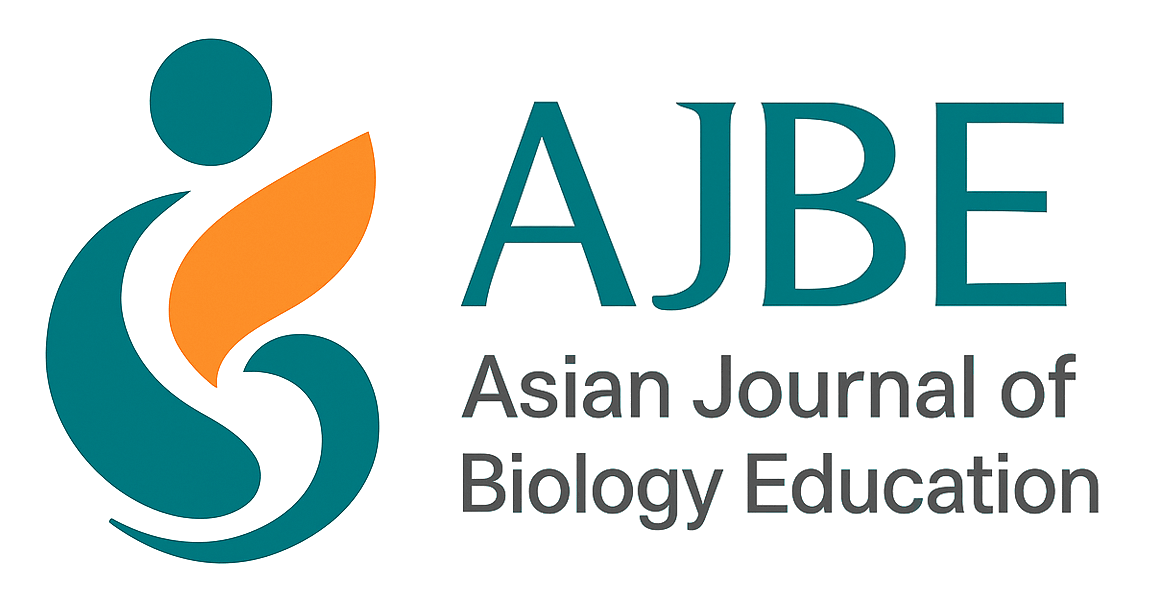Papers in the AJBE
Papers can be in the following six categories. Papers categorized as Review, Research Paper/ Research Note, Practical Report/Practical Note, and Biological Resource, are invariably refereed. Those categorized as Country Report are also peer-reviewed if needed.
1. Review: this category aims to provide a link between scientific research findings and the classroom. The aim is to provide teachers with up-to-date information on key areas. The reviews should give a clear and concise summary of a biological or educational topic. Articles for this section are intended to review educational topics relevant to a biology curriculum. Articles based on biological topics or those of relevance to the management and design of curricula are also of interest. Theoretical or discussion papers which are intended to deal with key points relevant to biology education may be suitable for this section.
2. Research Paper/Research Note: these will form the main body of the Journal. The research in any aspect of biology education should be carried out in conformity with the methodology of scientific research. Research Paper (full paper) is basically composed of an abstract, introduction, methodology (materials and methods), results, discussion and conclusion(s), and references. The manuscript should be written clearly and concise. The methods and results should be described along with both conclusions and implications for future research and teaching practices. Conclusions should be drawn logically based on the results. Their importance will be introduced against the background of a critical review of the relevant literature. Research Note is intended to be a short article which reports novel findings worthy of urgent publication. Research Note is composed of an abstract, introduction, materials and methods, results and discussion, and references. Although an abstract is not necessarily required, for the reader’s convenience, it is desirable to include a brief description of the paper. A clear demarcation between sections may not be necessarily required.
3. Practical Report/Practical Note: this section aims to give practical advice. Case studies into any aspect of education practice may be included. Practical Report (full paper) is desirable to contain an abstract, introduction, methodology (materials and methods), results, discussion, and references. The article should clearly describe a laboratory or classroom-based exercise or fieldwork which can be related to biological curriculum. The exercise described should have been subjected to trial in an educational setting. This section may also include descriptions of other innovations and developments, such as the use of teaching aids and the implementation of software packages. The emphasis will be on the nature of the practice, a clear description of the implementation procedure, and an evaluation of its success. Authors are recommended to present details of the suppliers listed in the materials section. Practical Note (short article), which describes a novel teaching/learning aid or teaching strategy, is of interest. As well as Research Note, such manuscripts do not necessarily need an abstract or to be divided into sections.
4. Country Report: this section aims to give readers the latest information about biology education and environmental education in the Asian and neighboring countries.
5. Biological Resource: this section aims to give information about biological science research whose results are considered to be useful for resources of biology education at a certain level of education. The author(s) should refer to how the results or the research itself are useful for biology education at that level.
6. Miscellaneous Article: opinions or outlooks on biology education or environmental education, and other articles which give some information about biology education, teaching aids, printed and electronic references, etc. will also be included in this category.
Abstracts of the papers presented orally or in poster form at an AABE biennial conference are not included in the categories listed above and will automatically be published as parts of the Conference Report (Note 1) .
Publication Ethics
The Editorial Board of AJBE is aware that the autonomy of science is based on the trust and commitment of society. Thus, the Editorial Board forbids the fabrication, falsification plagiarism, double contributions, gift-authorship, and human rights violations to the authors. If any misconduct is found in a contributed article, etc., the Editorial Board will either not publish the article or cancel its publication. In addition, the Editorial Board will take some appropriate measures, by considering the degree of misconduct and the responsibility of the author(s), such as banning submission of a paper for a certain period of time or claiming to pay compensation for damages. Further information on the AJBE Publication Ethics is provided on the corresponding web page on the AABE web site.
For detailed information on our publication ethics and policies regarding research misconduct, please refer to the AJBE Publication Rules and Ethics.
Note 1: AABE will publish abstracts of oral/poster presentations at the AABE Biennial Conferences as part of the Conference Report in a subsequent volume of the AJBE. These abstracts are simply reprinted from the Programme and Abstract booklet distributed at the Biennial Conference and are not peer-reviewed independent articles of the AJBE. They are not treated as published articles and cannot be referenced as previously published articles. Therefore, oral and poster presenters may submit the contents of their presentations as new research papers to AJBE and other journals.
